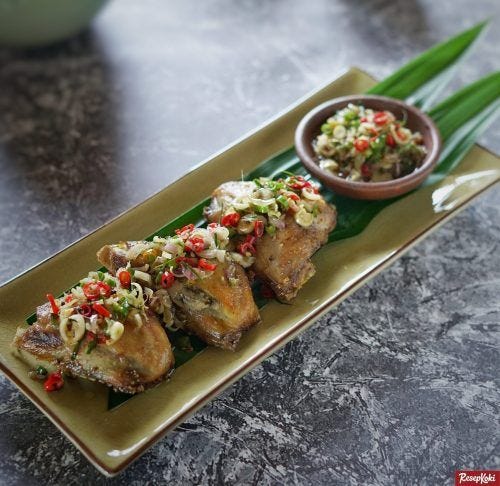Taste of Indonesia: Nasi Campur
Make the Art of Crafting Easy Nasi Campur: Indonesia’s Flavorful Delight
I have eaten nasi campur all my life, like all Indonesians do. Nasi campur ( nasi rames in Javanese ) means” mixed rice”, similar to a rice bowls in other part of Asia.
Why do I write about this now? Well, to transport your mind to Indonesia is through food.. You have to taste it, imagine how you would enjoy it there, and then, maybe make up your mind to plan for the real trip :)
If that’s the plan, be on the look out for my local recommendation for BEST WARUNG JAWA / Nasi Campur
in Bali.
Formally, Nasi Campur, a beloved dish in Indonesian cuisine, embodies the rich tapestry of flavors and culinary heritage of the archipelago. Featuring a variety of small portions of dishes served alongside rice, Nasi Campur offers a tantalizing array of tastes and textures in every bite.
By incorporating the aromatic spices and bold flavors of Bali, you can elevate this beloved dish to new heights of deliciousness.
In different part of Indonesia, nasi campur is sold in a cantina or we call it a “warung” that displays the food in a buffet style or glass display case.
Nothing can go wrong with nasi campur! Even a sidewalk warung can be as delicious as the restaurant version.
In Padang - Sumatera, their nasi campur version is called “Nasi Padang”. We will explore that next time!

https://lokasiterdekat.com/wp-content/uploads/2023/06/Nasi-Padang-Terdekat.jpg
I would love to inspire you to try this dish before you come to Indonesia. We'll explore how to create a simple yet delicious version of Nasi Campur, with a special Bali twist featuring spiced chicken and sambal matah.
Fried chicken with sambal matah (Resepkoki.id)
Ingredients:
Spiced chicken:
- 500g boneless chicken thighs, thinly sliced
- 4 cloves garlic, minced
- 1 tsp fresh ginger, grated
- 1 tsp turmeric powder or freshly grated
- 1 tsp coriander powder
- 1 tsp cumin powder
- 1 tsp chili powder (adjust to taste)
- 1 tsp lemongrass powder (or from a tea bag) or chopped fresh lemongrass
- Salt and pepper to taste
- 3 tablespoon vegetable oil
Sambal matah (spicy salsa):
3 Fresh Red chilli, chopped
5 shallots, chopped
Chopped fresh lemongrass or lemongrass powder (from a tea bag)
Warm coconut oil / avocado oil (neutral taste oil)
Salt to taste
Rice component:
- Cooked white rice (plain or cooked in coconut milk)
- Sautéed vegetables (such as long beans, spinach, or cabbage)
- Sliced cucumber
- Fried tofu or tempeh / Fried eggs with green onion (you can use all or pick one)
- Shrimp crackers / lime wedges (optional)
- Fried shallots (for garnish)
Instructions:
1. Marinate the chicken: In a bowl, combine the minced garlic, grated ginger, turmeric powder, coriander powder, cumin powder, chili powder, soy sauce, vegetable oil, salt, and pepper. Add the sliced chicken thighs to the marinade, ensuring they are evenly coated. Cover and refrigerate for at least 30 minutes to allow the flavors to meld.
2. Cook the spiced chicken: Heat a pan over medium-high heat and add a drizzle of oil. You could also deep fry the chicken like Indonesians do.
Once hot, add the marinated chicken slices and cook for 5-7 minutes, or until golden brown and cooked through. Remove from heat and set aside.
3. Prepare the condiments: Arrange the cooked white rice on serving plates. Place small portions of sambal matah, sautéed vegetables, sliced cucumber, fried tofu or tempeh, fried eggs, and shrimp crackers alongside the rice.
4. Assemble the Nasi Campur: Place a generous portion of the spiced chicken on top of the rice. Garnish with fried shallots for extra flavor and texture. Serve with fresh lime wedges on the side for squeezing over the dish.
5. Enjoy: Mix and match the different components of Nasi Campur to create your perfect bite. The combination of savory spiced chicken, zesty sambal matah, and aromatic rice makes for a truly satisfying meal that celebrates the vibrant flavors of Bali.
Nasi Campur offers a unique culinary experience that captures the family heritage of Indonesian cuisine. Each upbringing can affect how different families make their nasi campur. Meaning, with your own upbringing, you could easily make your own version, as long as you add rice (nasi) and spicy sambal.
In my family for example, with Javanese and Maduranese influence, we loved spicy sambal with funky shimp paste (a.k.a Terasi) cooked until caramelized or make them fresh and extra spicy. And, everything fried has to be a little blackened 😀 Yeah, add that extra bite and crunchyness into my dish!
I promise I would also bring this up on my next article, everything you need to know about Indonesian sambal! 🙂
So gather your ingredients, fire up the stove, and embark on a flavorful journey to Bali with homemade Nasi Campur.
Selamat makan! (Bon appétit!)




